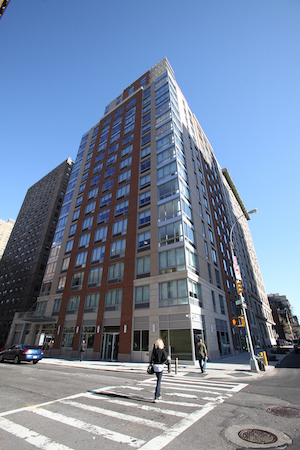
BY YANNIC RACK | To save and preserve the city’s affordable housing for future generations, the New York City Housing Authority (NYCHA) needs to reinvent itself on many levels, according to Shola Olatoye, the authority’s chair and CEO.
“Our salvation is in the light,” Olatoye said during a recent interview, referring to NYCHA’s need for more transparency — which she cautioned must be balanced with finding new revenue streams, since the authority’s operating budget has been cut by $1 billion since 2001.
After years of declining federal and state funding, the authority now has around $17 billion in capital debt.
“You don’t make up $1 billion in funding. You just don’t…those are real structural issues. That’s less staff, less repairs, less supplies,” Olatoye said. “We can’t do anything if we’re essentially, functionally bankrupt.
Her comments, made during an interview at the Brooklyn offices of Chelsea Now and our sister publications, come at the end of a year of heavy criticism on many fronts — most prominently from City Comptroller Scott Stringer, who has audited NYCHA six times in the past two years.
At the meeting, Olatoye discussed a range of issues, but started off with an introduction to NextGeneration NYCHA, the plan that was launched earlier this year to revive the authority over the next decade.
Whereas many housing authorities across the country have changed and adapted in recent years, Olatoye said NYCHA has largely stood still.
“If the status quo were to continue, we project that there would be a $2.5 billion operating deficit going forward. So we know that the status quo can’t continue,” she said.
To implement reform, the authority has identified 15 strategies that range from improving rent collection to connecting residents to employment opportunities.
The most challenging feat — getting back to a balanced operating budget — is to be pulled off with a combination of new revenue streams, including better management of the approximately 1.5 million square feet of ground-floor commercial space NYCHA owns, as well as coming up with potential uses for an additional 1 to 1.5 million square feet of non-residential community space.
“Like every plan, it’s somewhat of a financial exercise,” Olatoye said.
NYCHA estimates that the second stream could bring in $6 to 7 million in annual revenue over the next 10 years — peanuts compared to the hundreds of millions that the authority estimates could be raised over the same period by a third potential revenue source: an ambitious but controversial plan to develop under-utilized NYCHA-owned land.
In addition to locking down outside funding to support NYCHA’s most expensive properties — according to Olatoye, around 15,000 of NYCHA’s units take up 20 percent of the authority’s capital need, but only represent 6 percent of its actual building portfolio — the plan would create 10,000 units of affordable housing over the next decade.
NYCHA expects this to generate around $100 to 200 million in revenue over the next 10 years.
The more controversial component of the plan, however, is the “NextGen Neighborhoods” program, which would allow developers to build half affordable and half market-rate housing on public land.
This so-called “infill housing” is a cornerstone of the mayor’s affordable housing plan, but many public housing residents are opposed to the proposal because it could cost them coveted green or parking space.
The affordable units would be capped at 60 percent of the Area Median Income (currently around $46,600 for a family of three) and NYCHA hopes that the developments would generate anywhere between $300 to 600 million for the authority.
“We’re committed to affordable housing, but we need to raise some money,” Olatoye said.

The program is already slated for two complexes, one in Brooklyn and another on the Upper East Side, and Olatoye said NYCHA would certainly look to expand it to other areas with “hot real estate markets” over the next 10 years — although she wouldn’t go into specifics as to where.
“I think this is a dynamic process and we’ll be adding more sites to the program as we go on,” she said.
Regarding the concerns and fears of residents, she sympathized, but also reinforced that the need for new revenue is dire.
“It’s always easy to stand on the sidelines and scream, and it’s harder to come up with solutions,” she said. “And in the meantime, these buildings are literally crumbling. There is no sort of white knight, there is no silver bullet.”
One person regularly screaming has been comptroller Stringer, whose suggestions for reform at NYCHA include requiring the authority to follow the same budgeting rules as every other city agency, including issuing quarterly reports and creating a four-year financial plan, as well as releasing more information on maintenance requests and repair records.
When prompted on this, Olatoye emphasized NYCHA’s recent strides at becoming more accessible — like launching the MyNYCHA app that lets residents schedule repairs — but also said that change takes time.
“I do believe that transparency is incredibly important…but we’re also trying to change culture,” she said.
Asked about her stance on the smoking ban proposed by Julian Castro, who, as the US Secretary of Housing and Urban Development (HUD), oversees all local housing authorities, Olatoye remained vague.
“I think the real issue here is enforcement. And if you talk to my colleagues in the private sector, they’re gonna tell you about the same challenge — what are you gonna do, sniff people’s apartments? And with no additional resources?”
A spokesperson for NYCHA said the authority was currently reviewing HUD’s proposed new rule and plans to comment on it, although it was not immediately clear when that would happen.
Olatoye also admitted that there still is “huge room for improvement” in NYCHA’s relationship with residents and tenant associations overall, especially in the face of a move away from the traditional all-inclusive community model.
“I think while they’re incredibly frustrated [with NYCHA’s failings], they also want to make sure that it’s around for another generation, and I think that leads to some of that fear,” she said of the residents. “But there might be some glimmers of hope. And I hope they feel that.”

















